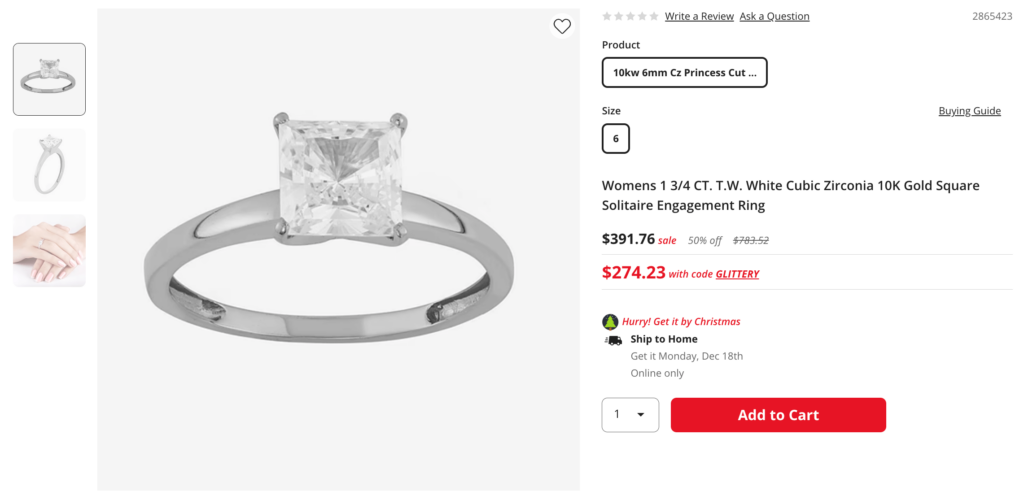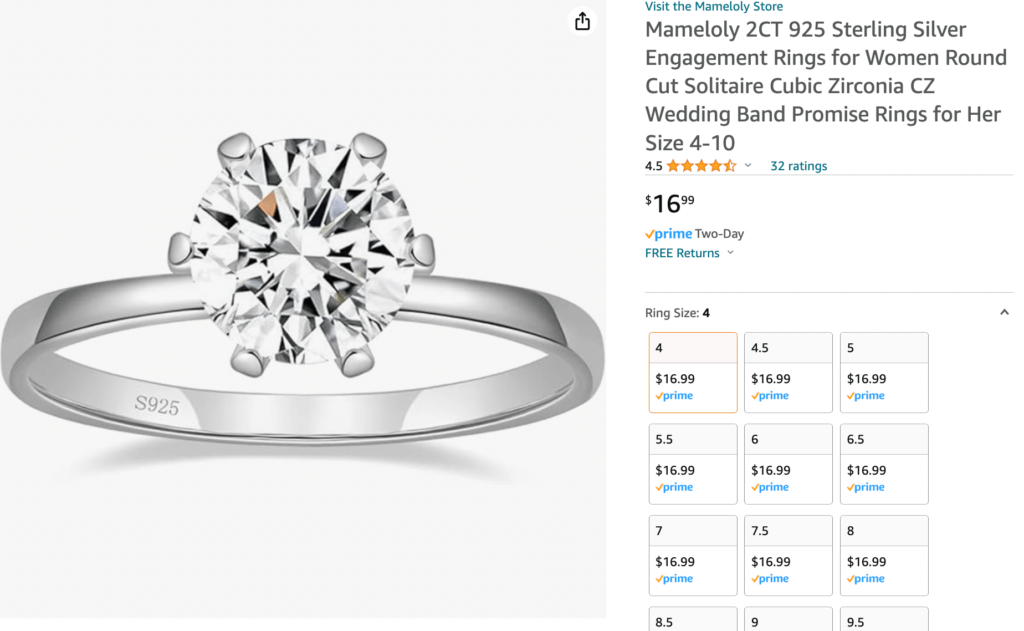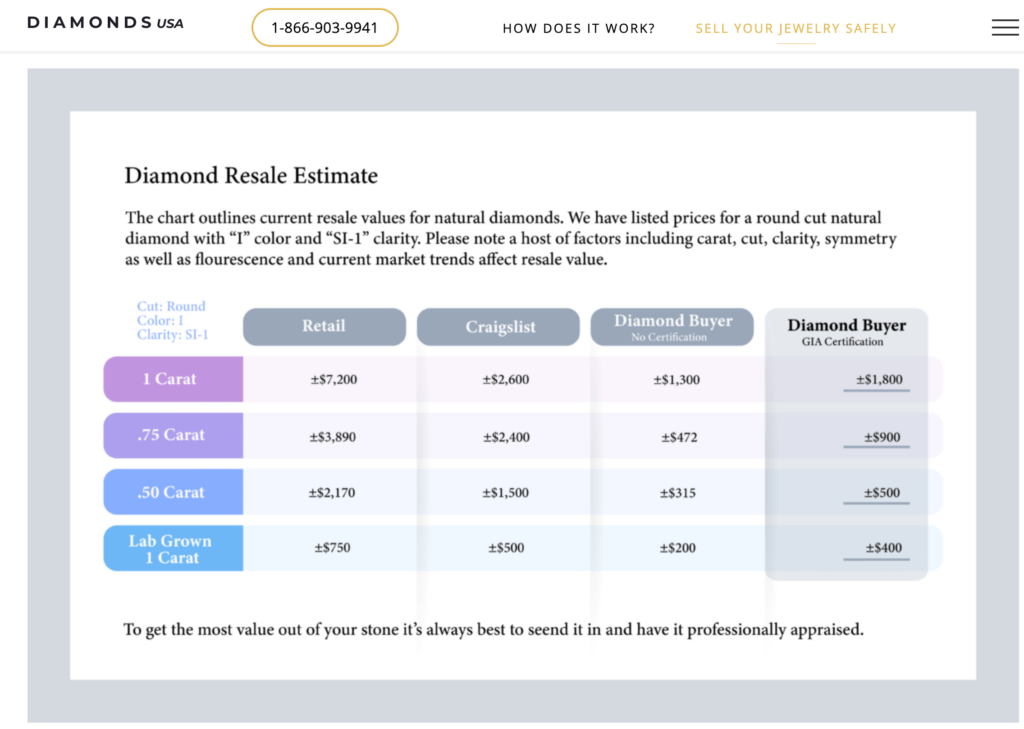Cubic zirconia is a type of diamond simulant — a “fake diamond” — that is extremely affordable. However, it doesn’t hold any value over time like a real diamond and loses its luster in just a few years.
“Cubic zirconia stones can sparkle and mimic the appearance of genuine gemstones, at least to an untrained eye, but they lack the durability and timelessness associated with natural diamonds and other precious gemstones,” says Anna Radunsky, an independent jeweler based in Brooklyn, N.Y.
Alternatively, lab diamonds, which have the same chemical and physical properties as real diamonds, are an affordable and more durable option if you’re shopping for an engagement ring on a budget.
However, if you’re considering cubic zirconia as a budget engagement ring option or you’re looking to purchase inexpensive fashion jewelry, we’ll help you understand:
- What cubic zirconia is
- Difference between cubic zirconias and diamonds (including lab-grown diamonds)
- Cubic zirconia pricing
- Cubic zirconia resale value
- Why a lab-grown diamond is a better alternative for an engagement ring
What is cubic zirconia?
Cubic zirconia is a lab-made diamond simulant that’s meant to mimic the appearance of a real diamond, but at a fraction of the price.
According to the Gemological Institute of America (GIA),1 cubic zirconia was discovered as a natural mineral in 1937 but didn’t hit the consumer market until 1976 after commercial production became possible. At that time, cubic zirconia became the most popular diamond imitation, before Moissanite entered the market in the late 90s.
While lab diamonds were first produced by General Electric in the 1950s, scientists didn’t perfect the process of making high-quality gemstones that could be produced commercially until the 70s. As production costs have gone down and quality improved, lab diamonds have gained in popularity, especially among environmentally conscious brides.
Today, cubic zirconia is primarily used in inexpensive fashion jewelry.
Is cubic zirconia a real diamond?
Cubic zirconia is not a diamond. Rather, it is a synthetic gemstone made in a lab as a budget-friendly alternative to a diamond. While natural and lab-grown diamonds are made of carbon, cubic zirconia is made of zirconium dioxide (ZrO2).2
The “cubic” in cubic zirconia comes from the stone’s cubic crystalline form, which it shares with its true diamond counterpart. Cubic zirconia is cut like a real diamond to mimic its appearance.
While diamonds are known for their durability, cubic zirconia is more fragile, at only 8-8.5 on the Mohs scale of hardness, while a diamond is a 10. According to the International Gem Society, cubic zirconia scratch easily and lose their luster after about two years.3
If you do choose cubic zirconia for an engagement ring, expect to replace the stone every few years if you want it to look its best.
What is cubic zirconia made of?
Cubic zirconia is made from zirconium dioxide, which most often occurs naturally in the mineral baddeleyite, though it can also be derived from the mineral zircon.
Manufacturers produce cubic zirconia by melting zirconium dioxide and adding minerals like magnesium and calcium to act as stabilizers. As the mixture cools, crystals form, and the piece is cut into a diamond-like shape.
Additional minerals may be added to give a tinted color to the stone instead of a clear, white finish.
How is cubic zirconia graded?
Cubic zirconia is not graded on the diamond scale (based on color, cut, clarity, carat size). Some retailers rate cubic zirconias on an overall quality scale from 1A to 5A (with 5A being the highest quality), though IGS warns that there is no standard rating scale and little difference in quality between any cubic zirconia stone, since they are mass produced.
Cubic zirconia are denser and heavier than diamonds of the same size. For example, a 6.5-mm diamond is about 1 carat, while a 6.5-mm cubic zirconia is about 1.7 carats.
Learn more about diamond appraisals and how diamonds are graded.
Cubic zirconia vs natural diamonds: How to tell the difference
There are several ways to identify whether a piece of jewelry contains a natural diamond or cubic zirconia:
1. Durability
Natural diamonds have a Mohs hardness scale rating of 10.3 That means they won’t scratch, even with everyday wear. Cubic zirconia, however, only has an 8-8.5 rating. If your stone has any scratches on the surface, it’s likely cubic zirconia or another diamond simulant, like Moissanite (9.25 hardness rating).
While you can buy a Mohs testing device online, it may cost you upwards of several hundred dollars for an effective model. Alternatively, you can take your stone to a certified gemologist or jeweler to have it tested.
2. Imperfections
If you notice a stone has a slightly yellow appearance or contains little dark specks inside (called inclusions), it’s likely a real diamond. Lab diamonds may also contain inclusions, though they are less likely than those on mined diamonds.
Cubic zirconia does not have inclusions, though it may contain tiny gas bubbles of unmelted zirconium dioxide powder.3
3. Brilliance
Check your jewelry under natural lighting. A real diamond reflects white light, while cubic zirconia reflects rainbow-colored light. Moissanite also reflects rainbow light.
Cubic zirconia vs diamond: Price
The price difference between cubic zirconia and real diamonds is substantial.
While diamond value fluctuates over time, cubic zirconia value consistently stays about the same (though it has no resale value).

Understanding cubic zirconia price
A natural diamond can cost several thousand dollars per carat, while most cubic zirconias are available for less than $30, according to Brides.com.5
It’s difficult to find a 100% side-by-side cost comparison of a diamond engagement ring vs. a cubic zirconia engagement ring, since most major jewelers do not sell comparable products of both. However, I pulled two rings from JCPenney, both in a 10K white gold solitaire setting.
This square-cut cubic zirconia ring was on sale for $274.23. Its carat weight is listed as 1¾, which is about the same weight as a 1-carat diamond:

A ring with a 1-carat round diamond was on sale for $1,076.91:

However, there were plenty of cubic zirconia rings on sale for less than $30. Prices were largely dependent on the metal used in the ring’s setting:
For example, this 2-carat cubic zirconia ring set in sterling silver was just $16.99 on Amazon:

Cubic zirconia vs natural diamond: Resale value
Cubic zirconia is a budget-friendly diamond alternative, but because it’s manufactured in mass, this type of stone does not hold value over time.
“It's quite inexpensive to purchase new cubic zirconia, so there's limited incentive to purchase a used CZ or a ring featuring one,” says Ty Wilson, co-founder and COO of CustomMade, an online custom jewelry designer based in Cambridge, Mass.
According to IGS,3 cubic zirconia are porous and can dull over time from the oils on skin.
“In a few years, cubic zirconia stones will lose their shine, which is not something that would ever happen to a diamond,” Radunsky says. “That’s part of the reason why they don’t retain resale value.”
The good news is that you can factor in the value of your gold, silver, or platinum setting when determining the resale value of your jewelry. Ring settings are usually priced by the scrap price of the metal used. Gold and platinum have the highest resale values.
As of , the spot gold value in the United States was trading at $ per ounce, or $ per gram.
Platinum spot price was per ounce as of .
As of , the silver resale value in the United States was at $ per ounce, or $ per gram.
If you have a cubic zirconia piece set in gold or silver, we recommend selling to top online gold buyer CashforGoldUSA because:
- A+ BBB rating
- High user reviews and ratings
- Buys all gold, silver and diamonds — no matter the weight or quality
- Up to $100,000 insurance
- 100% highest-offer guarantee, and free shipping both ways
- Get paid within 24 hours of accepted offer
- 10% bonus if you ship within 7 days
CashforGold’s sister site, Diamonds USA, buys all sizes of natural and lab-grown diamonds, and shared this chart to show the resale market of each. Both are worth more if sold with a GIA certificate. Diamonds USA does not buy cubic zirconia:

Is it easy to sell cubic zirconia jewelry?
Jewelers and online jewelry buyers will be more interested in the scrap value of your setting rather than the cubic zirconia stone itself.
Other options include selling your jewelry to a pawn shop, on consignment, or directly to independent buyers on sites like ebay, Facebook Marketplace, or Craigslist. You can also try an online consignment store like Poshmark or Mercari.
Cubic zirconia vs moissanite
Moissanite is a naturally occurring mineral that is replicated in labs to look like a diamond. One major difference is that moissanite has a 9.25 hardness rating on the Mohs scale.
That means it is much more durable and scratch-resistant than cubic zirconia and therefore a more practical diamond alternative.
Both moissanite and cubic zirconia have a fiery shine, which reflects rainbow light rather than white light like a diamond.
However, one major difference is that moissanite is doubly refractive, while cubic zirconia is singly refractive like a diamond. This means that when you examine both stones with a 10x loupe — a small magnifying glass used by jewelers — a moissanite’s facets (its flat triangle features) will appear doubled or fuzzy.
Learn more about the differences between moissanite vs. diamonds and other fake diamonds.
| Moissanite | Cubic Zirconia | |
| Composition | 50% carbon, 50% silicon | Zirconium oxide, magnesium, calcium |
| Color | Nearly colorless | Naturally colorless |
| Hardness | 9.5 on Mohs scale | 8-8.5 on Mohs scale |
| Brilliance | 2.65 refractive index | 2.15 to 2.18 |
Cubic zirconia vs lab diamond
Lab-grown diamonds are physically and chemically the same as real diamonds. That makes them much more expensive than cubic zirconia, but still significantly cheaper than natural diamonds.
Lab-grown diamonds are becoming incredibly popular, and less expensive by the month, and many couples are opting for lab-grown diamonds over natural diamonds for engagement rings, both for ethical and financial reasons.
If you are looking for a cheaper alternative to mined diamonds, lab-grown diamonds are a better option than cubic zirconia because they are as durable as a natural diamond.
Cubic zirconia will not maintain its luster beyond a few years and will need to continually be replaced if you want it to look its best.
Learn more about the lab-grown diamonds, how they’re priced, and their resale value.
| Lab-Grown Diamond | Cubic Zirconia | |
| Composition | Carbon | Zirconium oxide, magnesium, calcium |
| Color | Naturally colorless | Naturally colorless |
| Hardness | 10 on Mohs scale | 8-8.5 on Mohs scale |
| Brilliance | 2.42 refractive index | 2.15 to 2.18 |
Cubic zirconia vs diamonds FAQs
If you are thinking about buying cubic zirconia, here’s what else you should know:
Which is better, cubic zirconia or diamond?
Diamonds are more durable and highly sought-after stones. However, cubic zirconia is a budget-friendly diamond alternative if you aren’t concerned about resale value and are working on a tight budget.
You should also consider that you may have to replace your stone every few years if you opt for a cubic zirconia.
If you want a long-lasting piece of jewelry that is more likely to fetch a competitive resale price in the future, a diamond is the better option.
If you are looking to save money, a lab diamond is a less expensive option with all the beauty and durability of a mined diamond.
Learn more about how to sell diamonds and diamond jewelry and about diamond resale value.
How much is cubic zirconia worth?
Cubic zirconia is inexpensive to begin with and doesn’t grow in value over time. It should not be considered an investment piece.
Is cubic zirconia good quality?
Cubic zirconia only has an 8-8.5 rating on the Mohs hardness scale, which means it’s prone to scratching and breaking over time. The stone is also porous, which means it will absorb oils and other outside substances over time and lose its luster.
Bottom line: Understand the differences between cubic zirconia vs diamond before you buy or sell
Cubic zirconia is a great option for individuals on a tight budget who still want the general look of a diamond. However, it isn’t meant to be resold at a higher value (or any value at all).
The price will only go down as technological advances make it easier to create and more cubic zirconia enters the market. Consider all of this before making a decision to either buy cubic zirconia jewelry.
SOURCES
- “Cubic Zirconia: An Update,” Gems & Gemology, Spring 1981, Vol. 17, No. 1. Gemological Institute of America. https://www.gia.edu/gems-gemology/spring-1981-cubic-zirconia-nassau
- “Cubic Zirconia Vs. Diamonds,” International Gem Society. https://www.gemsociety.org/article/cubic-zirconia-vs-diamonds/
- “Mohs Hardness Scale,” National Park Service. https://www.nps.gov/articles/mohs-hardness-scale.htm
- “Cubic Zirconia Versus Diamonds: What's the Difference?” Dec. 12, 2022. https://www.brides.com/cubic-zirconia-vs-diamonds-5225482#

